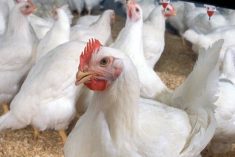The organization representing food and beverage companies in the province says it is not confident that a national grocery code of conduct will meet its deadline this November.
Read Also

Local farm businesses, groups look forward to Manitoba Ag Days 2026
Most of agriculture is seemingly at Manitoba Ag Days each January: Manitoba agribusinesses and farm groups look forward to connecting with farmers at the 2026 show.

Michael Mikulak, executive director of Food and Beverage Manitoba, said the code has already missed two deadlines since development started in summer 2021.
“What sort of bubbled this to the surface was some of these fines that companies were laying on (manufacturers),” he said. “People don’t realize that there’s things like shelving fees. It’s incredibly expensive to get into the grocery stores often and to be successful in that and some of those barriers really do need to get reduced if we are to value a more local, resilient food system in the future.”
Why it matters: Pandemic pressures and, more recently, consumer sticker shock at the grocery store, have brought the developing Grocery Code of Conduct into the spotlight.
Friction between grocers and those closer to the base of the supply chain hit a boiling point in 2020, with centralization in the grocery sector emerging as the main issue.
Various fees and fines levied by grocers had been longstanding bones of contention between the sectors. The debate escalated during the pandemic.
Some fees were linked to the switch to e-commerce, translated by manufacturers as grocers passing the buck on that investment cost.
There was little mercy for shipment disruptions caused by COVID-19, those same manufacturers argued, nor was there easy ability to increase their own prices as costs like commodity prices soared.
Grocery prices and food security have been high in the public consciousness, particularly in 2022 as inflation rises.
In June, Statistics Canada reported that food prices had increased by 9.7 per cent between April 2021 and the same month this year. Food Banks Canada reported that visits to food banks had jumped more than 20 per cent between 2019 and 2021.
Code of Conduct
In 2021, federal, provincial and territorial ag ministers tasked a steering committee with development of a grocery code of conduct. The roster spanned 10 industry associations, including the Canadian Federation of Agriculture, Retail Council of Canada (which represents grocers), Food and Beverage Canada, the Dairy Producers Association of Canada and the Fruit and Vegetable Growers of Canada.
Work began that summer with hopes of getting a proposed code on paper by the end of the year.
As the clock ticked down on 2021, however, it became clear that no draft would be ready. A new deadline was set for March of this year, only to be missed again.
Following the second missed deadline, the committee formed a working group in an attempt to work out the impasses.
Michelle Wasylyshen, spokesperson for the Retail Council of Canada, said discussions shifted from broad strokes to the fine detail as of April.
“The complexity of developing a grocery industry code of conduct cannot be overstated,” she said. “It involves many constituents representing a broad mix of industry and retail partners, each with diverse needs and concerns, and this process takes time.”
By July, the steering committee said consensus had been reached on general principles of the code. Issues involving stocking fees, consumer complaints, “unsellables,” shrinkage, changes to supply chain procedures and standards for agreements were also in progress, the committee reported.
There was agreement that any code would have to be mandatory and, failing voluntary support from companies, might need regulatory teeth behind it.
“Singular provincial and territorial codes will only disrupt business and potentially impact small to medium-sized businesses,” a July report read. “The code should also consider the trade implications and not disadvantage domestic businesses including growers, ranchers, fishers and harvesters and grocery manufacturers.”
Others topics remain mired in debate. Force majeure policies (a contractual clause that releases both parties in cases of unforeseen circumstance), the scope of products impacted by the code, cost price indexing, payments, fines and fees, among other issues, are still contested.
“We are currently at a critical period within the code of conduct development process,” the committee said. “Unless there is progress on the points noted above, we will not achieve the alignment necessary to move forward.”
The committee is still developing the dispute resolution and governance structure that would underpin enforcement.
The little guy
Mikulak argued that small manufacturers have little chance against the highly centralized grocery sector. Most of the almost 200 companies represented by his organization are small, he noted.
“It really does prohibit a lot of these smaller players, and these smaller players are important from a local food system resilience standpoint,” he said.
Many small companies face their own supply shortfalls. Some are purchasing one to two years’ worth of certain ingredients or packaging to lock in price and supply, Mikulak said.
But increases in manufacturers’ costs are difficult to bring to the next step of the value chain, he said, and as price takers, many may be operating at a loss “or they’re producing at such a small margin that, really, they can’t continue.”
Things are further complicated by a fundamental shift in the food and grocery industry.
Mikulak pointed to increased emphasis around sustainability, reduced carbon footprints, corporate environmental claims and population-level health outcomes.
In this case, centralization in the grocery sector might actually accelerate that transition, as big companies also face consumer pressure on metrics like sustainability and have more capital and reach in their policy changes.
Mikulak said the grocery code will be a critical part in that transition, helping ensure small companies don’t get left behind. Supportive government programs will also help.
Large manufacturers can make short-term carbon-reduction claims using offsets, but those same offsets would be out of reach for a small, family-owned firm, he added. For them, carbon reduction would require ingredients with less carbon footprint.
That is tricky in an ag industry already balking over increased scrutiny on operations.
Smaller players often do not have the ability or data needed to support environmental claims, added Mikulak.
“If we want certain outcomes to change in the food system, we have to make sure that the incentives and programs are designed to make that transition possible so that we don’t just have a winner-take-all scenario.”
Moving forward
In late July, Manitoba Agriculture Minister Derek Johnson had no comment on the code’s development. However, it may yet fall in the laps of the provincial, territorial and federal governments.
Following the ag ministers’ meeting in July, the steering committee said it would ask ministers to intervene if an agreement cannot be reached by November. It’s also expected that a draft of the code will be released for wider consultation.
“The steering committee remains strongly committed to taking all necessary steps to ensure a Grocery Industry Code of Conduct (is developed) that supports fairness in the commercial dealings between suppliers, independent retailers and large Canadian retailers, to ensure that we support the long-term sustainability and growth of this country’s agricultural community, Canadian food, health and consumer goods manufacturing sectors and Canadian retailers of all sizes,” Wasylyshen said.
















